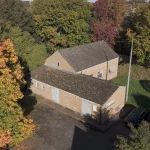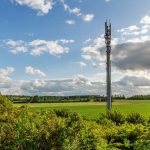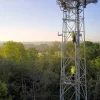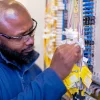BT Bring FTTC and FTTP to 2.7M UK Apartments and High Rise Buildings
BTOpenreach, which maintains BT’s national UK telecoms network, has revealed that 2.7 Million apartments (Multi Dwelling Units) or high rise buildings around the United Kingdom can now access its superfast broadband service (i.e. up to 80Mbps FTTC or 330Mbps capable FTTP). But 550k more will soon follow.
The effort is part of BT’s commercial £2.5bn roll-out of fibre optic based broadband services, which has so far passed 15 million premises (about half of all UK premises) and eventually aims to reach 66% of UK homes and businesses by spring 2014.
Advertisement
It follows on from an earlier 2011 pilot of Fibre-to-the-Premises (FTTP) technology in High Rise Buildings (here) that initially focused on several buildings in the Isle of Dogs part of East London (e.g. West India Quay, Canary Riverside and Port East). At the time BT said it wanted 1,000 buildings to take part in the pilot.
But the latest information also reveals that, out of the 2.7 million total, some 608,000 now represent apartments in Greater London and a further 550,000 are expected to “get access over the coming years“.
Mike Galvin, BT Openreach MD for NGA Broadband, said:
“Residents of high-rises are very quick to cotton-on to the benefits of super-fast fibre connections, and landlords realise that by offering fibre connectivity, they can seriously increase the attractiveness of their property“.
Galvin also used the example of London’s Canary Wharf, which is apparently the setting for BT’s “largest deployment to date of [FTTP] technology within apartment buildings“, to illustrate his point.
In particular he noted that 40% of residents in the New Atlas Wharf building have already connected to a related service from their ISP, which is a lot better than the national figure of 7% for superfast broadband uptake (Ofcom). But this is of course a very selective example taken from a dense urban area.
Advertisement
However he also noted that three other apartment blocks in the area (West India Quay, Port Eas, and Burrell’s Wharf) have had FTTP technology installed and apparently all of them show take-up rates of over 30%.
At the same time it’s important to remember that BT isn’t the only game in town. Fledgling ISP Hyperoptic has also had a strong focus on London and recently secured a new investment of £50m to help expand its 1000Mbps capable network into 10 new UK cities or 80,000 homes by the end of 2013 (here).
Likewise Virgin Media’s superfast cable (EuroDOCSIS3) platform also tends to focus on urban areas, though its top speeds are currently capped at 120Mbps. But don’t be surprised if this increases to around 200Mbps in the near future and DOCSIS3.1 technology could eventually take this even further (here).
Mark is a professional technology writer, IT consultant and computer engineer from Dorset (England), he also founded ISPreview in 1999 and enjoys analysing the latest telecoms and broadband developments. Find me on X (Twitter), Mastodon, Facebook, BlueSky, Threads.net and Linkedin.
« UPDATE2 TalkTalk Make Fibre Broadband Available to New Line Customers
















































Comments are closed